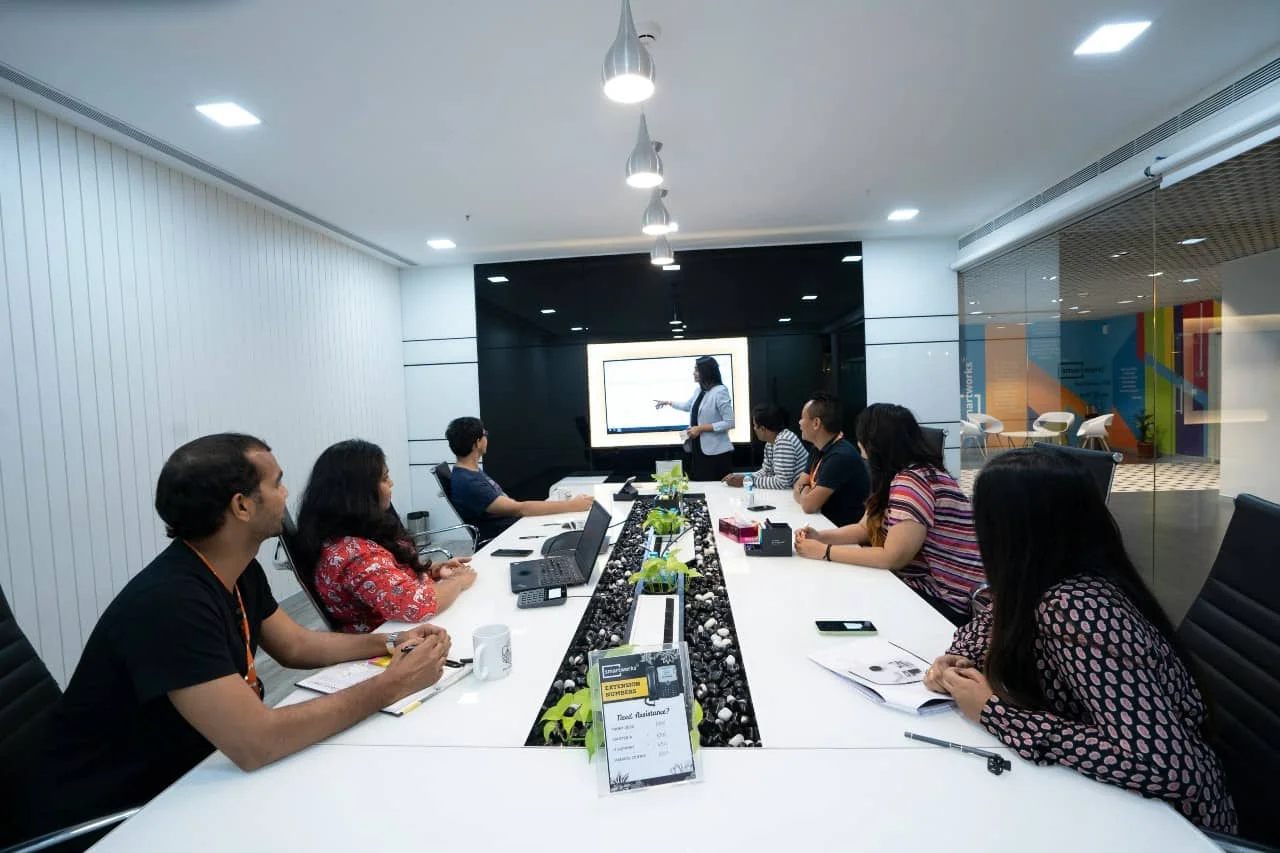360 feedback assessment: what it is, who its for & how to implement at your organization
360 feedback assessment guide: what it is, who its for & how to implement at your organization
The term “Feedback” can mean different things to different people but for most people, the idea of getting feedback - let alone asking for it - ranks up there with a trip to the dentist.
In the workplace, the 360 assessment is the #1 tool used to facilitate people in gathering feedback on their professional abilities helping them to confirm their strengths and understand areas of opportunity for development.
The 360 offers a multi-perspective view of an individual’s performance and behavior within an organization.
Despite the massive potential upside of 360’s, misconceptions and apprehension often surround 360-degree feedback, leading to fear and mistrust.
In this article, we demystify 360-degree feedback, addressing common fears and mistakes while highlighting its potential for talent development, optimization & leadership growth.

What is 360-degree feedback?
Before we dive into the transformative potential of 360-degree feedback, we’ll start with the basics.
So what exactly is 360-degree feedback?
Imagine it as your own personal mirror reflecting not just what you see in front, but also everything happening around you.
At its core, the 360-degree feedback assessment is a process in which an individual’s performance, behavior & core competencies are assessed by a diverse group of people who interact with them in a professional capacity. This group of people typically includes peers, subordinates, supervisors, and sometimes even clients or customers.
How is it used?
One of the primary applications of 360-degree feedback is employee development.
It provides employees with valuable insights into their strengths and areas for improvement, allowing them to take ownership of their growth journey.
What’s the best way to use a 360?
The key to unlocking the potential of 360-degree feedback lies in its proper utilization.
A well-designed and executed 360 assessment can lead to profound personal & professional development.

360 evaluations as part of talent optimization
Providing a 360-degree feedback assessment to employees or taking one yourself can provide insight and validation regarding what skills are showing up as strengths and where there are opportunities for further development.
The 360 can be used to reinforce specific skills and behaviors that are linked to development plans and can help provide a clear development path and ensure a company has the right skills to both achieve its goals and reinforce the right culture.
When used appropriately as a part of talent optimization, 360’s foster personal and professional development, refine leadership skills, and ultimately contribute to the overall success of individuals and the organization as a whole.
360 feedback benefits
The 360, when executed effectively, unlocks a multitude of benefits. Below we explore how each type of participant can gain from this valuable experience:
Benefits for employees
Employees stand to gain substantially from engaging in a 360-degree feedback assessment.
Primarily and most importantly, this opportunity allows them to embark on a journey of personal growth.
By receiving a direct report containing actionable feedback from multiple stakeholders, employees can identify their strengths and areas for improvement with greater clarity leading to:
- Enhanced job performance
- Increased job satisfaction
- And ultimately, career advancement
Additionally, the improved teamwork and communication skills that evolve out of the feedback processes contribute to a more harmonious work environment.
Benefits for managers
Managers can leverage the 360-degree feedback process to their advantage as well.
Engaging in this assessment empowers them with a comprehensive view of their leadership skills and management style, equipping them with valuable insights into how they are perceived by their team members, superiors, and peers.
Armed with this knowledge, managers can then:
- Fine-tune their leadership approach
- Make more informed decisions
- and ultimately become more effective leaders
This not only benefits their careers but also elevates their teams and the organization as a whole.
Benefits for leaders
Leaders at all levels of the organization can reap substantial rewards by participating in a 360 assessment.
For leaders, this process serves as a continuous learning and growth opportunity.
By actively seeking feedback and acting upon it, leaders foster a culture of openness & adaptability within the organization, thereby:
- enhancing their leadership capabilities
- encouraging innovation
- ensuring they remain at the forefront of their domains
This process demonstrates adaptability and allows them to lead with authenticity and make a lasting impact.
Benefits for senior leaders
Even seasoned senior leaders can benefit immensely from taking part in a 360-degree feedback assessment.
The 360 provides them with fresh perspectives and keeps them at the pinnacle of their performance, helping to ensure they maintain their distinguished positions within the organization, not only securing their leadership legacy but also ensuring the organization’s continued success.
By embracing feedback and making any necessary adjustments, senior leaders will continue to guide the organization toward sustained excellence.
Overall, the benefits of participating in a 360-degree feedback assessment are substantial for all parties and levels involved.

How Does the 360-Degree Evaluation Work?
Now that we understand the various applications of 360-degree feedback we can delve into the mechanics of how this evaluation process actually works.
The 360 feedback process
The key components of the 360 Feedback Process include:
Participants - Feedback is collected from a circle of participants that typically includes the individual’s manager, peers, direct reports, and sometimes even clients or customers. In some cases, the individual may also self-assess as part of the process.
Questionnaire - The feedback is usually gathered via an online assessment or through an interview. Questions focus on various competencies and performance areas relevant to the individual’s role. These questions might assess areas such as communication skills, teamwork, leadership qualities, problem-solving abilities, and customer service. We are biased to online 360 assessments for ease of use, data analysis, and ability to rate people at the same time which leads to greater precision.
Anonymity - 360s generally provide anonymous feedback to encourage honest and constructive feedback. The anonymity helps reduce bias and retaliation concerns, allowing raters to provide genuine insights without fear of repercussion.
Compilation and Analysis - Once collected, the feedback is compiled and analyzed, often by HR or an external provider. The aim is to identify patterns, strengths, and areas for development, rather than focusing on isolated comments or scores.
Feedback Delivery - The results are then shared with the individual, typically in a feedback session led by a manager, HR professional, or an external coach. This session is crucial for interpreting the feedback constructively and setting actionable goals for personal and professional development.
Action Planning and Follow-Up - The final step involves the individual creating an action plan to address the feedback, with specific goals and strategies for improvement. Follow-up sessions may be scheduled to review progress.
In the world of performance management, 360-degree feedback is not so much a vs question but one of being complimentary. 360’s often stand in stark contrast to traditional performance reviews.
Let’s explore the differences and why 360-degree feedback should be your go-to tool for development vs just relying on performance reviews:
Advantages & disadvantages
Like any tool, 360-degree feedback has its strengths and weaknesses. Let’s break down the pros and cons, weighing the benefits against the potential pitfalls, and how to mitigate the potential pitfalls.
Here are the advantages and disadvantages of the 360-degree assessment:
Advantages
Comprehensive Feedback - By gathering insights from various sources, the 360-degree assessment provides a more holistic view of an employee’s performance, capturing different perspectives.
Increased Self-awareness - Employees gain a better understanding of how their work is perceived by others, which can highlight discrepancies between their self-perception and the perception of others, leading to increased self-awareness.
Personal and Professional Development - Feedback from multiple sources can identify areas for improvement and strengths, guiding personal and professional development plans. It can be particularly effective for developing soft skills such as teamwork, leadership, and communication.
Enhanced Feedback Culture - Implementing a 360-degree assessment can promote a culture of open and constructive feedback, encouraging continuous improvement and open communication.
Performance Improvement - By identifying gaps in skills and behaviors, the 360-degree feedback can lead to targeted training and development efforts, improving overall performance.
Disadvantages
Time-consuming Process - This is especially true if doing an interview 360. Collecting, managing, and analyzing feedback from multiple sources can be time-consuming for HR departments and the employees involved in providing and receiving feedback.
Potential for Bias: Despite its comprehensive nature, the feedback can still be subject to biases (e.g., personal grudges, favoritism) that can skew the results and impact the fairness of the assessment.
Overwhelming for Employees - Receiving feedback from multiple sources can sometimes be overwhelming or confusing, particularly if the feedback is contradictory or if the employee is unprepared to process it constructively.
Misuse of Feedback - If not properly facilitated, feedback can be misused for punitive measures rather than development, damaging trust and morale within the team or organization.
Requires Training - To be effective, participants in the 360-degree feedback process (both givers and receivers of feedback) require training on providing constructive feedback and interpreting and using the feedback they receive.
While the 360-degree feedback assessment can offer valuable insights for employee development and organizational growth, it requires careful implementation to mitigate its disadvantages, including clear communication, training, and safeguards against biases.

What is the most important benefit of a 360 feedback review?
On the surface, 360-degree feedback is known as a tool for confirming strengths and identifying growth opportunities.
But the true power of the 360 lies in its ability as a personal marketing tool.
Changing a person’s perception is no small feat. Think back to when you made a mistake and left a negative impression.
How long did it take to correct that perception?
With 360-degree feedback, individuals can not only identify areas for improvement but also communicate their commitment to growth and change to their colleagues and superiors. Follow up on this communication with a visible behavior change.

How to design an effective 360-degree feedback review program for your organization
Now that we understand the benefits and intricacies of 360-degree feedback, it’s time to explore how organizations can design & implement effective feedback programs tailored to their own unique needs.
Designing an effective 360-degree feedback review program
Implementing a 360 requires careful planning and consideration.
Below are the 10 essential steps to designing an effective 360 feedback program that will accelerate leadership competencies and unlock employee performance:
Step 1: Define objectives
Before diving into the feedback process, organizations must clearly define the objectives they aim to achieve through 360-degree feedback.
These objectives could range from improving leadership skills to enhancing team collaboration.
Defining these objectives clearly & concisely sets the direction for the entire program.
Step 2: Select participants
Choosing the right participants is critical to the success of the program.
Participants should include peers, subordinates, supervisors, and other relevant stakeholders who can provide valuable insights.
It’s essential to ensure diversity in the feedback providers to get a well-rounded, actionable view.
Step 3: Identify the assessment
The heart of the 360-degree feedback process lies in the assessment.
Organizations should identify a trusted assessment that can also be tailored to the objectives and competencies they want to assess.
Questions should be clear, specific, and aligned with the organization’s goals.
Step 4: Communicate clearly
Effective communication is key to a successful feedback program.
Organizations should clearly explain the purpose, process, and benefits of the 360 to participants.
Address any concerns and ensure confidentiality to encourage honest and constructive feedback.
Step 5: Conduct the assessment
Once the questionnaires are prepared and participants are briefed, it’s time to conduct the assessment.
Participants should complete the assessments for the individuals they are evaluating.
The process should be streamlined and user-friendly.
Step 6: Analyze the data
Collecting feedback is just the beginning; the real value lies in analyzing the data.
If you are using an online 360, you should be able to analyze the data in various methods, allowing you to understand various leadership skills across a team, division, or enterprise thematically.
This analysis helps identify patterns, strengths, and areas for improvement and can inform hiring decisions, training investments, and even readiness for significant initiatives.
Step 7: Provide feedback
After analyzing the data, it’s time to provide feedback to the individuals being assessed.
This feedback should be constructive, focused on specific behaviors, and aligned with the organization’s objectives.
Step 8: Develop action plans
Feedback without action is meaningless.
Organizations should have feedback processes and work with individuals to develop action plans based on the feedback received.
These action plans should be realistic, measurable, and linked to personal and organizational goals.
Step 9: Continuous follow-up
360-degree feedback is not a one-time event; it’s an ongoing process.
Organizations should schedule regular follow-up sessions to track progress, make adjustments to action plans, and ensure that feedback leads to meaningful change.
Step 10: Evaluate & adjust
Periodically, organizations should evaluate the effectiveness of their 360-degree feedback program, collect feedback from participants, and make necessary adjustments to improve the performance review process continually.

360-degree feedback example questions & answers
The success of a 360-degree feedback program depends on the questions asked. In this section, we’ll provide a comprehensive list of example questions and answers for different levels within the organization.
The 360 feedback structure
Below are the points that we spoke about as to skyline not using basic questions & answers and how we may be able to finesse this section in regards to “Questions & Answers” and “360 Feedback Template”. I’ve included my notes from meeting
360 items can be questions or statements. Our 360 is composed of 28 items in the form of statements that are organized by the four pillars of our leadership competency model. The four pillars of our model are :
- Leading self
- Leading others
- Leading the Organization
- Leading Implementation
Whatever 360 a company launches, the items should align with the skills and behaviors that they need from their people.

Best practices for implementing a 360-degree feedback system for your organization
Implementing a 360-degree feedback system is a complex process. In this section, we’ll outline best practices needed to implement the practice, and ensure a smooth, successful process with an advantageous outcome.
Best practices for implementation
Leadership buy-In
Ensure that top leadership supports and participates in the 360-degree feedback process, setting an example for the entire organization.
Clear communication
Communicate the purpose, process, and expectations clearly to all participants, emphasizing the confidential nature of feedback.
Customization
Tailor the assessment criteria and questions to align with your organization’s specific goals and competencies.
Action planning
Collaborate with individuals to create actionable development plans based on their feedback, ensuring alignment with organizational objectives.
Continuous improvement
Regularly review and refine the 360-degree feedback process based on feedback from participants and evolving organizational needs.

How to choose the best 360 survey solution for your organization?
Selecting the right survey solution is crucial for the success of your 360-degree feedback program.
Below are the key criteria to consider when choosing the best potential solution for your organization’s unique needs.
Key criteria for choosing a 360 survey solution
Opt for a user-friendly online platform that makes it easy for participants to complete assessments and access results.
Large normative database
Choose a solution with a robust normative database that allows you to compare individual performance to industry benchmarks.
Ease of use
The survey tool should be intuitive and require minimal training for participants and administrators.
Group and team comparison
Look for features that enable you to compare feedback results across groups and teams within your organization.
Leadership competency model
Ensure that the survey is based on a sound leadership competency model that aligns with your organizational goals.
Detailed reporting
Select a solution that provides both quantitative and qualitative data in detailed direct reports, making it easier to identify areas for improvement.

What happens after the 360?
The journey doesn’t end with the completion of a 360-degree feedback assessment. In fact, it’s just the beginning.
Below are the critical post-assessment steps that organizations should take to ensure that the feedback leads to tangible growth and development.
Post-assessment steps
Feedback Debrief Session: Every 360 should be debriefed by a qualified expert who can help individuals interpret the feedback and develop an action plan.
Action planning session
Facilitate a session where individuals, with the guidance of experts, set goals linked to their 360 feedback and job objectives. These goals should be verified by the person’s manager for alignment.
Regular check-Ins
Schedule follow-up meetings to track progress on action plans, provide support, and make any necessary adjustments.
Integration into development plans
Incorporate feedback from 360 assessments into individuals’ career development, plans and performance evaluations.
Continuous improvement
Continuously assess the impact of 360 feedback on an individual’s development and overall organizational performance, adjusting as needed.
In conclusion, the 360-degree feedback assessment development tool isn’t a tool to be feared but is invaluable for reshaping people’s perceptions, improving work performance, and driving organizational growth.
When harnessed effectively, it catalyzes personal and professional development, ushering in positive changes in individuals, teams, and organizations.
Instead of viewing the 360 with apprehension, embrace the 360-degree perspective to shift perspectives and fuel growth.
In a world where the pursuit of leadership excellence is ongoing, 360-degree feedback emerges as a beacon of opportunity, fostering self-awareness, employee growth, transformation, and enhanced organizational success. Embrace it, leverage its potential, and witness your organization and its leaders thrive like never before.

Looking to develop your workforce with a 360?
Whether you’re in human resources looking to improve employee evaluations and overall employee performance or you’re a senior leader looking for personal development for yourself and other senior leaders, the 360 performance appraisal provides honest feedback on critical competencies.
Contact us today to learn more about our 360 appraisals and leadership development programs.















